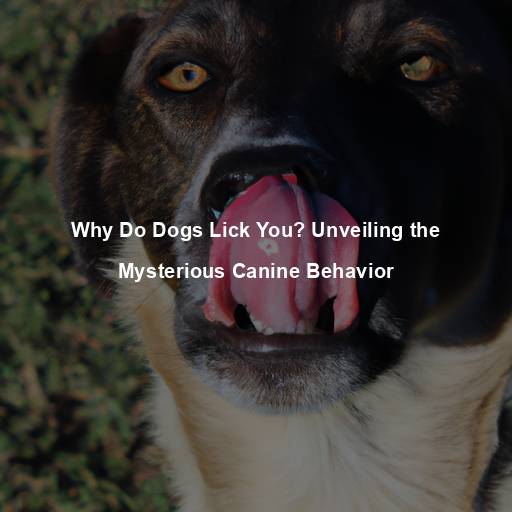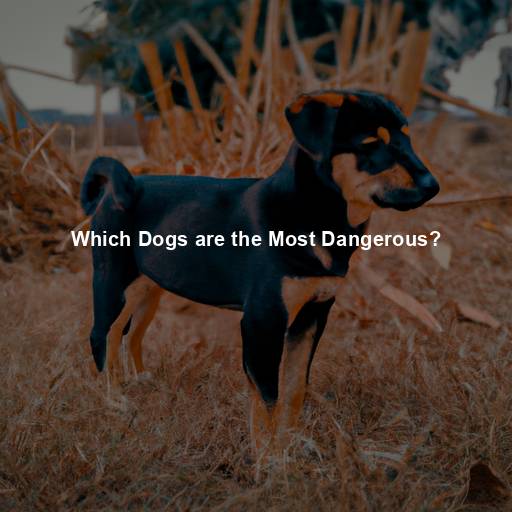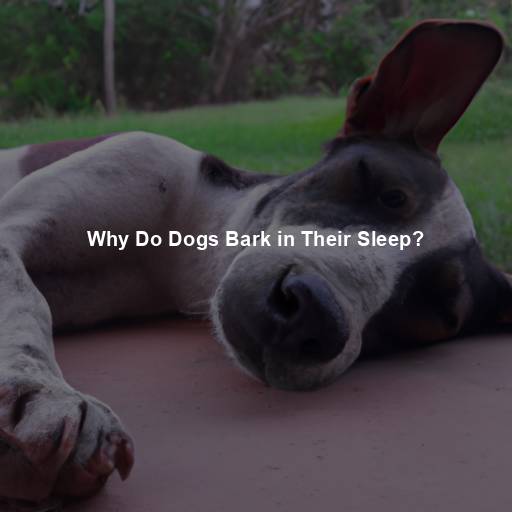Why Do Dogs Lick You? Unveiling the Mysterious Canine Behavior
Last Updated on July 8, 2023 by Evan
Contents
- 1 The Curious Habit of Canine Licking
- 1.1 A Natural Canine Instinct
- 1.2 Communication and Social Bonding
- 1.3 Taste and Exploration
- 1.4 Seeking Attention and Affection
- 1.5 Stress Relief and Self-Soothing
- 1.6 Cleaning and Grooming Instincts
- 1.7 Medical and Health Considerations
- 1.8 How to Manage Excessive Licking
- 1.9 Embracing the Licking Phenomenon
- 1.10 The Power of Scent: Licking and Identification
- 1.11 Licking as a Display of Submission
- 1.12 Licking and Emotional Expression
- 1.13 The Art of Interpretation: Decoding Your Dog’s Licking Behavior
- 1.14 Encouraging Healthy Licking Habits
- 1.15 Embracing the Canine Love Language
- 1.16 Neurological Rewards: The Pleasure of Licking
- 1.17 Olfactory Stimulation: Licking and Scent Detection
- 1.18 Learned Behavior and Reinforcement
- 1.19 Cultural and Environmental Factors
- 1.20 When Does Dog Licking Become a Concern?
- 1.21 A Fascinating Canine Behavior
- 2 FAQs: Why do dogs lick you?
The Curious Habit of Canine Licking
Ever wondered why our beloved furry friends give us those wet, sloppy kisses? The act of dog licking is a phenomenon that can both warm our hearts and leave us perplexed. From a gentle caress of the hand to a full-on face cleaning session, dogs seem to have an inexplicable urge to shower their human counterparts with affectionate slobber. But what motivates this behavior that spans the spectrum from adorable to exasperating?
A Natural Canine Instinct
Licking, an ancient and instinctual practice deeply ingrained in our canine companions, traces back to ancestral times. From the very moments of birth, puppies absorb the art of licking, nurtured by their caring mothers. This behavior carries a myriad of purposes, such as cleansing the young ones and triggering essential bodily functions, as well as forging an unshakable bond between mother and offspring. As these furry friends mature, their licking tendencies continue to evolve and manifest in captivating ways, leaving us in awe of nature’s perplexing designs.
Communication and Social Bonding
The art of licking holds immense significance in the intricate world of canine communication. Dogs have mastered this peculiar form of interaction to express a multitude of sentiments towards both their four-legged peers and human counterparts. A tender lick from a dog is laden with a deep sense of affection, love, and unwavering trust, as if to proclaim, “You, dear human, have become an integral part of my pack, and I hold you dear”. These exchanges foster an unbreakable bond, reinforcing the profound relationship between a dog and its owner while simultaneously aiding them in carving their niche within the intricate tapestry of social hierarchy.
Taste and Exploration
Just like us humans rely on our taste buds to discover and engage with the world, our furry friends, dogs, have their own unique way of using their sense of taste to explore their surroundings. Through the simple act of licking, dogs are able to capture a taste of their environment, whether it’s delving into an intriguing scent or indulging in a novel object. This sensory experience serves as a valuable way for dogs to gather important information about their surroundings, aiding them in comprehending and maneuvering through the perplexing realm they call home.
Seeking Attention and Affection
Dogs are highly social animals and crave attention and affection from their human companions. Licking is often a way for dogs to seek interaction and show their desire for attention. When a dog licks you, they are actively seeking your acknowledgment and engagement. It’s their way of saying, “I want to be close to you, and I want you to notice me”.
Stress Relief and Self-Soothing
Licking can also serve as a self-soothing mechanism for dogs, particularly in stressful or anxiety-inducing situations. Similar to how humans may engage in activities like nail-biting or hair-twirling when feeling anxious, dogs may turn to licking as a way to alleviate their stress. The rhythmic motion and repetitive action of licking can have a calming effect on dogs, helping them cope with emotional distress or anxiety.
Cleaning and Grooming Instincts
Another reason for dogs’ propensity to lick is their inherent grooming instincts. Dogs are naturally inclined to keep themselves clean, and licking plays a significant role in their grooming routine. By licking their fur, dogs remove dirt, debris, and parasites from their coat, maintaining good hygiene and health. This grooming behavior is also believed to have a soothing effect on dogs, providing them with a sense of comfort and well-being.
Medical and Health Considerations
When it comes to dogs and their tendency to lick, there’s a fine line between normal and excessive. If your furry friend is going lick-a-licious all day long, especially in certain spots, it might be a clue that something fishy is going on. We’re not talking about the occasional lick here and there, but rather a licking extravaganza that could indicate allergies, irritations, or even infections. To play it safe, keep an eye on this slippery situation and don’t hesitate to fetch a veterinarian’s advice if you’re feeling perplexed or concerned about your pup’s well-being.
How to Manage Excessive Licking
When it comes to your furry friend’s incessant licking, fret not! There’s a bevy of options to tackle this puzzling behavior head-on. Start off by ensuring your pup gets ample exercise and intellectual stimulation, as this can quell any underlying anxiety or tension. Equipping them with suitable chew toys and engaging in interactive playtime serve as marvelous distractions, channeling their licking inclinations elsewhere.
Embracing the Licking Phenomenon
In conclusion, the act of licking is a multi-faceted behavior in dogs that serves a range of purposes. From communication and social bonding to taste exploration and stress relief, licking is deeply ingrained in their nature. Understanding the reasons behind this behavior can help us strengthen our bond with our canine companions and provide them with the love and care they deserve. So the next time your furry friend showers you with slobbery kisses, embrace the lick and cherish the unique connection you share with your loyal four-legged companion.
Note: It’s important to remember that this essay provides a general understanding of why dogs lick, but individual dogs may have unique motivations and preferences. It’s always recommended to observe and understand your own dog’s behavior to ensure their well-being and happiness.## The Evolutionary Perspective: Tracing Licking Back to Wolves
Delving into the enigmatic world of canine behavior, we uncover the captivating roots of licking in dogs. Tracing back to their primal predecessors, wolves, this seemingly puzzling act has a profound evolutionary significance. In the wild, wolves utilize licking as a means of bolstering social bonds within their pack, an intricate web of connections and hierarchies. Our beloved pets, descendants of these majestic creatures, carry this age-old instinct within them.
The Power of Scent: Licking and Identification
It’s time to uncover the fascinating world of canine communication! Prepare to be amazed by the intricate art of licking, which takes center stage in scent-based interactions among our furry friends. Dogs possess a remarkable olfactory system, and through the act of licking, they engage in an intricate exchange of scents, embarking on a journey of discovery and knowledge about their fellow canines. When a dog bestows a lick upon you, they are essentially gathering your unique scent, enabling them to identify and acknowledge your presence as a cherished and trusted companion.
Licking as a Display of Submission
In the canine world, licking can also be a gesture of submission. When a lower-ranking dog encounters a higher-ranking individual, they may engage in submissive licking to display deference and respect. This behavior is often observed when a dog licks the face of their owner or another dominant figure. By licking, the dog is acknowledging the higher status of the individual and reinforcing the social hierarchy within the pack.
Licking and Emotional Expression
Licking is not solely a physical act for dogs; it is also an expression of their emotions. Dogs are highly attuned to their owners’ moods and emotions, and licking can be their way of providing comfort and support. When you’re feeling down or distressed, your dog may instinctively lick you as a means of offering solace and reassurance. The act of licking releases endorphins in both the dog and the recipient, promoting a sense of well-being and bonding.
Separation Anxiety and Licking
Licking, oh what a curious canine behavior! It seems that for certain furry friends, this action takes on a whole new level of intensity when faced with the perplexing turmoil of separation anxiety. In the absence of their beloved owners, these anxious pups turn to excessive licking, as if it were a secret antidote to their inner turmoil. This peculiar behavior acts as a self-soothing mechanism, offering them a comforting embrace in the midst of their solitude.
The Art of Interpretation: Decoding Your Dog’s Licking Behavior
While there are general reasons why dogs lick, it’s crucial to interpret your dog’s specific behavior to gain a deeper understanding. Each dog is unique, and their licking behavior may vary based on their personality, upbringing, and individual preferences. By observing your dog’s body language, context, and accompanying behaviors, you can decipher the meaning behind their licking. For example, if your dog licks you while wagging their tail and displaying a relaxed posture, it’s likely an expression of affection.
Encouraging Healthy Licking Habits
As dog owners, we often delight in our furry friends’ affectionate licks. However, it’s crucial to strike a balance and set some sensible limits to ensure their well-being. The seemingly innocent act of excessive licking can unexpectedly pave the way for unpleasant consequences like skin irritation or even painful sores. To tackle this issue head-on, we’ve outlined a few helpful strategies worth considering.
- Redirect the Behavior: Provide appropriate chew toys or interactive puzzles to redirect your dog’s licking behavior onto more suitable objects.
Encouraging positive behavior in your furry friend is key! Instead of getting caught up in excessive licking, reward them when they choose to engage in other activities and redirect their attention. By doing so, you’re helping them break the habit and form healthier habits while maintaining a loving and supportive bond.
Teach your beloved canine companion the art of discernment by implementing positive reinforcement training methods. Through this process, your furry friend will learn the fine balance between appropriate and discouraged licking behaviors. By establishing clear boundaries, you can guide your dog towards courteous and well-mannered interactions, while also ensuring their happiness and overall well-being. - Seek Veterinary Advice: If your dog’s licking behavior is persistent, compulsive, or accompanied by other concerning symptoms, consult with a veterinarian to rule out any underlying medical conditions.
Embracing the Canine Love Language
While the reasons behind why dogs lick may vary, one thing is certain: licking is an integral part of canine communication and social bonding. It’s a testament to the deep emotional connection between humans and their furry companions. So, the next time your dog showers you with wet kisses, embrace their affectionate gesture, and cherish the unique bond you share with your canine friend. Remember, their licking is an expression of love, trust, and their unwavering loyalty.
Have you ever wondered why our furry friends love to shower us in slobbery affections? It turns out that the science behind doggy licks is more complex than meets the eye. With researchers dedicating their time and energy to unravel the mysteries of this behavior, we’re able to delve into the fascinating world of canine licking. From theories about communication to potential health benefits, these scientific perspectives shed light on our four-legged companions’ penchant for licking.
Neurological Rewards: The Pleasure of Licking
Several intriguing studies have shed light on the remarkable connection between dogs and humans when it comes to licking. Interestingly, this seemingly simple act sets off a fascinating chain reaction, releasing a surge of endorphins, those delightful hormones that make us feel oh-so-good. It’s as if our brains have a built-in reward system that encourages us and our four-legged friends to engage in this behavior, not only for self-soothing but also as a means of stress relief. So, the next time you catch your furry companion enthusiastically indulging in a lick-fest, know that their pleasure centers are lit up, adding to their enjoyment and zest for life.
Olfactory Stimulation: Licking and Scent Detection
Have you ever wondered why dogs are so fixated on licking everything in sight? It turns out that this seemingly odd behavior actually serves a very important purpose. Dogs have a remarkable sense of smell, and licking allows them to gather valuable information about their surroundings. Whether they’re licking an object or a person, they are collecting scent molecules that provide them with crucial data.
Learned Behavior and Reinforcement
Licking can also be a learned behavior that is reinforced through positive experiences. For example, if a dog licks their owner’s hand and receives attention, praise, or treats in return, they learn that licking leads to positive outcomes. This positive reinforcement encourages dogs to continue the behavior, as they have associated it with rewards and attention. Therefore, it’s crucial to be mindful of the responses we provide to our dogs’ licking, as it can shape their future tendencies.
Cultural and Environmental Factors
The fascinating world of doggie behavior never ceases to amaze us! It turns out that both cultural norms and the environment play a crucial role in shaping our furry friends’ licking habits. In some cultures or households, a slobbery lick is seen as a loving gesture, while in others it might be frowned upon. But it doesn’t stop there!
Breed-Specific Licking Patterns
Interestingly, certain dog breeds may exhibit distinct licking patterns influenced by their genetics and breed-specific traits. For example, breeds with longer muzzles and tongues may engage in more extensive licking compared to breeds with shorter snouts. Additionally, some breeds are known for their grooming tendencies, and they may display more frequent and meticulous licking behaviors as part of their inherent grooming instincts.
When Does Dog Licking Become a Concern?
While licking is a natural behavior for dogs, excessive or compulsive licking can become problematic. It’s essential to recognize when licking crosses the line into behavior that requires attention or intervention. Here are some signs that your dog’s licking may be a cause for concern:
- Obsessive Licking: If your dog licks excessively and persistently, to the point where it interferes with their daily activities or causes physical harm, it may indicate an underlying issue that needs to be addressed.
- Skin Irritations or Sores: Excessive licking can lead to skin irritations, sores, or hair loss. If you notice any signs of skin damage or discomfort, consult with a veterinarian to determine the underlying cause and develop a treatment plan.
Have you ever noticed a sudden shift in your furry friend’s licking habits? Well, it turns out, there could be more to it than meets the eye. In some cases, these changes in behavior might be signaling an underlying medical issue, stress, or even anxiety. So, before you start scratching your head in perplexity, it might be worth seeking expert advice to unravel the true cause behind your dog’s licking frenzy.
A Fascinating Canine Behavior
Discovering the true essence behind a dog’s act of licking is like unraveling the intricacies of a kaleidoscope. It involves an intricate tapestry of innate tendencies, affectionate connections, olfactory sensitivities, and cognitive imprints gathered throughout their lives. The enigmatic nature of this behavior captivates our imagination, inviting us to delve into the realm of canine nonverbal communication and heartfelt expressions. Embracing this enigma unlocks a profound understanding of our furry friends, fostering profound bonds and nurturing their overall happiness.
FAQs: Why do dogs lick you?
Why do dogs lick humans?
Dogs lick humans for various reasons. One common reason is to show affection. Licking is a natural behavior in dogs that is associated with bonding and showing love towards their owners. It can also be their way of seeking attention or wanting to be petted. Another reason is that dogs use licking as a way to explore and understand their environment. By licking humans, they can gather information about you, including your scent and taste.
Is licking a sign of dominance in dogs?
No, licking is not necessarily a sign of dominance in dogs. While dogs may have dominant behavior traits, licking is generally not related to displaying dominance. Licking is a behavior rooted in their natural instincts and can be influenced by factors such as breed and individual personality. It is important to consider the overall context and other body language of a dog to determine their intent behind the licking behavior.
Why do dogs lick wounds or injuries?
There’s something quite mesmerizing about observing our canine companions attending to their injuries, isn’t there? The ingrained instinct to lick wounds has long intrigued us, as we marvel at their innate ability to cleanse the afflicted area from debris and lifeless tissue, almost like a delicate dance of self-healing. Beyond the awe-inspiring spectacle, this ancient ritual also serves to invigorate blood flow, igniting the healing process from within. Interestingly enough, this tender act of self-care triggers the release of endorphins, those marvelous chemical messengers that offer our furry friends a blissful reprieve from pain and a comforting embrace in times of distress. But as with all things, moderation is key, dear readers, as excessive licking has the potential to impede the very healing it hopes to expedite. Thus, let us remain vigilant and ensure our furry companions find the optimal balance between tending to their wounds and allowing them to heal gracefully.
Can dogs lick as a sign of anxiety or stress?
It’s no secret that our furry friends have their own unique ways of communicating their emotions. One behavior that often leaves owners perplexed is licking. While it may seem like a harmless act, dogs may actually resort to this repetitive action as a means of self-soothing when faced with anxiety or stress. Understanding the root cause of their distress is crucial in finding the right approach to address it – whether it be through behavioral training, making environmental adjustments, or seeking expert guidance. In cases where the licking becomes excessive or starts causing harm, consulting with a trusted veterinarian or animal behaviorist is a wise course of action.
Is it safe to let dogs lick your face?
Allowing dogs to lick your face is a personal choice, but there are certain considerations to keep in mind. While it is generally considered safe, it is important to be aware that the mouths of dogs contain bacteria that can potentially be harmful. These bacteria can be transmitted through licking, especially if there are any open wounds or sores on the skin. Additionally, some people may be allergic to dog saliva. If you have a compromised immune system or are concerned about potential risks, it may be best to avoid allowing your dog to lick your face or to wash your face thoroughly afterward.
How can I discourage excessive licking behavior?
If your dog’s licking behavior becomes excessive or unwanted, there are several strategies you can try to discourage it. Providing appropriate alternative behaviors like chew toys or interactive puzzles can redirect their excessive licking tendencies. Training your dog with cues such as “leave it” or “enough” can help establish boundaries and communicate your expectations. Consistency and positive reinforcement are key in modifying any unwanted behavior, so rewarding your dog when they exhibit calm or non-licking behavior can be effective. If the excessive licking persists, seeking guidance from a professional dog trainer or behaviorist can be beneficial.







